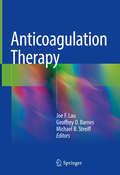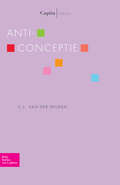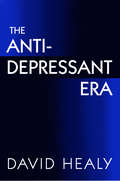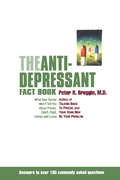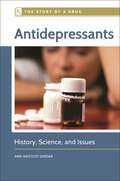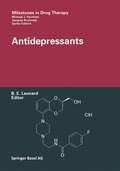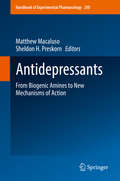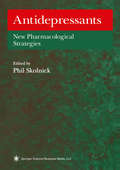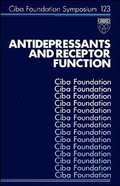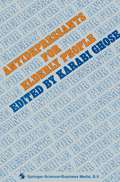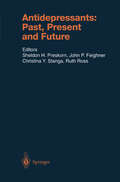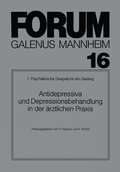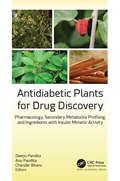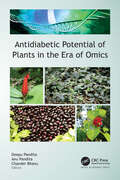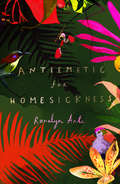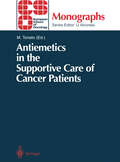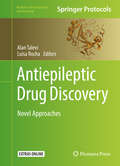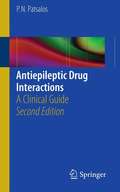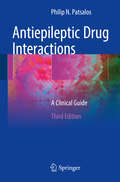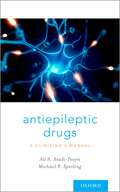- Table View
- List View
Anticoagulation Therapy
by Joe F. Lau Geoffrey D. Barnes Michael B. StreiffThis book presents the latest evidence and guidelines supporting the use of anticoagulant therapy for various clinical scenarios. The field of anticoagulation therapy is evolving rapidly, particularly since the arrival and widespread adoption of direct oral anticoagulants. Organized in two parts, this book reviews the pharmacologic properties of various anticoagulants and details the clinical applications of anticoagulant therapy. Drugs such as warfarin and unfractionated heparin, as well as parenteral and direct oral anticoagulants are discussed in terms of their pharmacokinetics, drug-disease interactions, dosing strategies, and risk considerations. Clinical applications of anticoagulant therapy in disorders such as acute coronary syndromes, atrial fibrillation, and thrombophilia and in special populations such as pregnant women, the elderly, and in the patient with cancer are highlighted. Clinical vignettes, algorithms, clinical pearls, and self-assessment questions are integrated throughout the book. Featuring contributions from authorities in the field, Anticoagulation Therapy is an essential resource for cardiologists, vascular medicine specialists, hematologists, internists, and all other healthcare professionals who prescribe anticoagulants.
Anticonceptie: Capita Selecta
by Carla Van Der WijdenHet deel Anticonceptie van de reeks Capita Selecta gaat in op thema's als HPV-vaccinatie, op latere leeftijd zwanger worden en de weerslag van ziekte en ouderdom op intimiteit en seksualiteit bij de steeds ouder wordende vrouw en man. De bijdragen zijn afkomstig uit de professionele vakliteratuur en geselecteerd door een expert op het terrein van de anticonceptie. Op die manier is gegarandeerd dat het thema op een gevarieerde en verrassende wijze wordt belicht.
The Antidepressant Era (PDF)
by David HealyWhen we stop at the pharmacy to pick up our Prozac, are we simply buying a drug? Or are we buying into a disease as well? An account of the phenomenon of antidepressants, this book relates how depression, a disease only recently deemed too rare to merit study, has become one of the most common disorders of our day and a booming business to boot.;This book chronicles the history of psychopharmacology from its inception with the discovery of chlorpromazine in 1951 to current battles over whether these powerful chemical compounds should replace psychotherapy. An expert in both the history and the science of neurochemistry and psychopharmacology, David Healy offers a close-up perspective on early research and clinical trials, the stumbling and successes that have made Prozac and Zoloft household names. The complex story he tells, against a backdrop of changing ideas about medicine, details the origins of the pharmaceutical industry, the pressures for regulation of drug companies, and the emergence of the idea of a depressive disease. This historical and neurochemical analysis leads to a clear look at what antidepressants reveal about both the workings of the brain and the sociology of drug marketing.;Most arresting is Healy's insight into the marketing of antidepressants and the medicalization of the neuroses. Demonstrating that pharmaceutical companies are as much in the business of selling psychiatric diagnoses as of selling psychotropic drugs, he raises disturbing questions about how much of medical science is governed by financial interest.
The Antidepressant Fact Book: What Your Doctor Won't Tell You About Prozac, Zoloft, Paxil, Celexa, And Luvox
by Peter BregginKnown as "the Ralph Nader of psychiatry," Dr. Peter Breggin has been the medical expert in countless court cases involving the use or misuse of psychoactive medications. This unusual position has given him unprecedented access to private pharmaceutical research and correspondence files, information from which informs this straight-talking guide to the most prescribed and controversial category of American drugs: antidepressants. From how these drugs work in the brain to how they treat (or don't treat) depression and obsessive-compulsive, panic, and other disorders; from the documented side and withdrawal effects to what every parent needs to know about antidepressants and teenagers, The Anti-Depressant Fact Book is up-to-the minute and easy-to-access. Hard-hitting and enlightening, every current, former, and prospective antidepressant-user will want to read this book.
The Antidepressant Fact Book: What Your Doctor Won't Tell You About Prozac, Zoloft, Paxil, Celexa, And Luvox
by Peter BregginKnown as "the Ralph Nader of psychiatry," Dr. Peter Breggin has been the medical expert in countless court cases involving the use or misuse of psychoactive medications. This unusual position has given him unprecedented access to private pharmaceutical research and correspondence files, information from which informs this straight-talking guide to the most prescribed and controversial category of American drugs: antidepressants. From how these drugs work in the brain to how they treat (or don't treat) depression and obsessive-compulsive, panic, and other disorders; from the documented side and withdrawal effects to what every parent needs to know about antidepressants and teenagers, The Anti-Depressant Fact Book is up-to-the minute and easy-to-access. Hard-hitting and enlightening, every current, former, and prospective antidepressant-user will want to read this book.
Antidepressants: History, Science, and Issues (The Story of a Drug)
by Ann Westcot JordanThis accessible volume offers a holistic exploration of this diverse class of drugs, from medical, historical, cultural, and economic perspectives.Depression is one of the most commonly reported mental disorders, and it affects millions of Americans. A wide variety of medications are used to treat depression, many of which have become household names—Zoloft, Prozac, and Paxil among them. Because these medications have the ability to alter how people think and feel, however, physicians must weigh a number of factors when prescribing them, especially to teens. Antidepressants: History, Science, and Issues, a part of Greenwood's Story of a Drug series, offers a robust exploration of antidepressant medications that covers the historical, ethical, medical, legal, and scientific dimensions of these drugs.After an introductory case study of a person with depression and this individual's problems and successes with antidepressants, the book provides an overview of depression and its various symptoms as well as the causes, prevalence, and diagnosis of depression. Readers will gain an understanding of the neurotransmission and specific mechanisms behind the activity of antidepressant medications; the effects and applications of these drugs, plus their associated risks of misuse and abuse; and related policy and societal issues.
Antidepressants: History, Science, and Issues (The Story of a Drug)
by Ann Westcot JordanThis accessible volume offers a holistic exploration of this diverse class of drugs, from medical, historical, cultural, and economic perspectives.Depression is one of the most commonly reported mental disorders, and it affects millions of Americans. A wide variety of medications are used to treat depression, many of which have become household names—Zoloft, Prozac, and Paxil among them. Because these medications have the ability to alter how people think and feel, however, physicians must weigh a number of factors when prescribing them, especially to teens. Antidepressants: History, Science, and Issues, a part of Greenwood's Story of a Drug series, offers a robust exploration of antidepressant medications that covers the historical, ethical, medical, legal, and scientific dimensions of these drugs.After an introductory case study of a person with depression and this individual's problems and successes with antidepressants, the book provides an overview of depression and its various symptoms as well as the causes, prevalence, and diagnosis of depression. Readers will gain an understanding of the neurotransmission and specific mechanisms behind the activity of antidepressant medications; the effects and applications of these drugs, plus their associated risks of misuse and abuse; and related policy and societal issues.
Antidepressants (Milestones in Drug Therapy)
by Brian E. LeonardImportant clinical issues as the outcome of long term treatment with antidepressants, the time of onset of the antidepressant response and the limitations of the antidepressants currently available are covered in this monograph. Leading researchers in the area of clinical and experimental psychopharmacology critically assess the progress in their specialist fields. The mechanisms of action of antidepressants are considered, followed by clinical research into the role of the hypothalamic-pituitary-adrenal axis and the immune system in the biology of depression and in response to treatment. The final chapter deals with the important chemical entities now undergoing development as antidepressants. The purpose of this monograph is not only to inform but also to stimulate research into the biology of depression and the mechanisms behind the action of effective antidepressants. This monograph is of interest to psychiatrists, psychologists, pharmacologists, neuroscientists and endocrinologists.
Antidepressants: From Biogenic Amine To New Mechanisms Of Action (Handbook of Experimental Pharmacology #250)
by Matthew Macaluso Sheldon H. PreskornThis volume reviews the known neurobiology of depression and combines classic data on antidepressant treatments with modern theory on the physiology of depression. It also discusses novel mechanism of action drugs.
Antidepressants: New Pharmacological Strategies (Contemporary Neuroscience)
by Phil SkolnickIn this book, leading-edge investigators offer effective strategies to improve current antidepressive therapies and suggest molecular, biological, and genetic approaches that will lead to the development of novel antidepressants. The contributors' critical reviews and commentaries illuminate our understanding of the mechanism(s) responsible for antidepressant action. The book's goal is to move beyond current biogenic amine-based concepts and therapies to the development of new and improved antidepressants that are more effective and have a more rapid onset than current.
Antidepressants and Receptor Function (Novartis Foundation Symposia #123)
by Gregory R. Bock Sarah Clark Ruth PorterCiba Foundation Symposium 123 Antidepressants and Receptor FunctionChairman: Dennis Murphy, 1986 Depression is a common and often debilitating affective disorder. Attempts to develop effective antidepressants have a long history, but many questions remain about the mechanisms of action of such treatments and about the aetiology and pathophysiology of depression itself. Early observations centred attention on central monoamine systems, and animal studies suggested that changes in beta-adrenoceptor responsiveness were a common effect of antidepressant therapies. More recent research has encompassed many different central and peripheral receptors, time-dependent adaptational events at synapses, and the functional significance of changes in neurotransmitter systems in both humans and experimental animals. Such pharmacological studies aimed ultimately at elucidating the neurochemical basis of depression and of promoting new therapeutic approaches, provide the focus of this symposium volume. Many different methods of investigating the links between monoamine systems, depression and antidepressant treatments are described. Recent studies of receptors and of monoamine uptake sites in the brain and the periphery (e.g. in platelets and fibroblasts) are reviewed, with emphasis on alpha and beta adrenoceptors, [3H]imipramine-binding sites and serotonin receptors. The results of monitoring amine metabolites in cerebrospinal fluid and of measuring neuroendocrine, physiological and behavioural responses to pharmacological challenge are presented, providing information on monoaminergic function in depressed patients and experimental animals before, during and after treatment with antidepressant drugs or electroconvulsive shock. Genetic influences on receptor density are also discussed, as is the relevance to human depressive illness of animal models, including stress-induced behavioural depression in rats and responses to social stressors in rhesus monkeys. This book should be of interest to neuropharmacologists, psychopharmacologists, clinical pharmacologists, behavioural scientists, psychiatrists and neuroscientists.
Antidepressants for Elderly People
by K. GhoseDepression is one of the commonest problems in old age. Yet until recently, old people were systematically exduded from participating in drug trials and similar investigations. As a result, knowledge regarding incidence, natural history and management of depression in the elderly are somewhat limited. It is now well-established that old people are sensitive to most psychotropic drugs and they tend to suffer from adverse effects and side effects of antidepressant drugs more frequently than any other age group. These are considered to be due to age-related physiological changes. In addition, because of the frequent association with multiple pathology, the elderly are likely to receive polypharmacy which further complicates the management of antidepressant drug therapy. The aim of this book is to provide a comprehensive guidance on the drug therapy of depression for the dinicians involved in the health care of the elderly. In the first section, epidemiology, presentations and assessment of depression in old age and neuroendocrine abnormalities observed in patients with depression are briefly discussed. However, it mainly deals with the problems of antidepressant drug therapy, such as which antidepressant to prescribe, how to monitor efficacy and side effects, what is the adequate dose, how long to treat a single episode of depression and who requires long term medication. Information regarding pharmacology, side effects, adverse effects, drug interaction and pharmacokinetics of most currently available drugs are provided. Special emphasis has been given on continuation therapy and the choice of an antidepressant drug and their long term safety.
Antidepressants: Past, Present and Future (Handbook of Experimental Pharmacology #157)
by Sheldon H. Preskorn Christina Y. Stanga John P. Feighner Ruth RossA comprehensive review of the current status of antidepressants - how we arrived at this point in their evolution and where we are going in both the near and the long term. It employs both a scientific and historical approach to accomplish these goals. This volume is intended for practitioners who use antidepressants on a daily basis in their practice as well as for the student and researcher. Each will find that it provides a comprehensive and logical approach to this important group of medications. This book is being published as we mark the end of the first 50 years of the modern antidepressant era.
Antidepressiva und Depressionsbehandlung in der ärztlichen Praxis
by V. Beck M. Berger L. Demisch M. Gastpar B. Geiselmann H. Hippius G. Laakmann G. Laux M. Ortner M. Philipp A. Rothenberger E. Rüther G. Schüssler M. WiegandAntidiabetic Plants for Drug Discovery: Pharmacology, Secondary Metabolite Profiling, and Ingredients with Insulin Mimetic Activity
by Deepu Pandita Anu Pandita Chander BhanuThis volume takes an in-depth look at the potential pharmacological applications of 11 important antidiabetic plants, examining their antihyperglycemic, hypoglycemic, and anti-lipidemic properties along with current genome editing research perspectives. Plant natural products, or phytoconstituents, are promising candidates for antidiabetic pharmacological actions. The phytoconstituents, such as fl avonoids, terpenoids, saponins, carotenoids, alkaloids and glycosides, play vital roles in the current and future potent antidiabetic drug development programs Each chapter reviews a particular plant with antidiabetic properties, explaining the therapeutic aspects, its active antidiabetic compounds, and relevant genome editing technology. The specific plants discussed include Azadirachta indica (commonly known as neem, nimtree or Indian lilac), Gymnema sylvestre (commonly called gymnema, Australian cowplant, and Periploca of the woods), Syzygium cumini (commonly known as Malabar plum, Java plum, black plum, jamun or jambolana), Ceylon cinnamon (or true cinnamon, as opposed to cassia cinnamon), insulin plant (or Costus pictus), Trigonella foenum-graecum (better known as fenugreek), Mulberry, Nigella sativa L. (black caraway, also known as black cumin, nigella, kalojeera, kalonji or kalanji), Aegle marmelos (L.) (commonly known as bael (or bili or bhel), also Bengal quince, golden apple, Japanese bitter orange, stone apple or wood apple), Ficus benghalensis (the banyan, banyan fig and Indian banyan), and of course, garlic (Allium sativum). Antidiabetic Plants for Drug Discovery: Pharmacology, Secondary Metabolite Profiling, and Ingredients with Insulin Mimetic Activity will serve as a valuable source of information for students, drug researchers, medical practitioners, diabetic patients, and many others in the effort to gain understand of how these plant drug molecules can help fight diabetes.
Antidiabetic Plants for Drug Discovery: Pharmacology, Secondary Metabolite Profiling, and Ingredients with Insulin Mimetic Activity
by Deepu Pandita Anu Pandita Chander BhanuThis volume takes an in-depth look at the potential pharmacological applications of 11 important antidiabetic plants, examining their antihyperglycemic, hypoglycemic, and anti-lipidemic properties along with current genome editing research perspectives. Plant natural products, or phytoconstituents, are promising candidates for antidiabetic pharmacological actions. The phytoconstituents, such as fl avonoids, terpenoids, saponins, carotenoids, alkaloids and glycosides, play vital roles in the current and future potent antidiabetic drug development programs Each chapter reviews a particular plant with antidiabetic properties, explaining the therapeutic aspects, its active antidiabetic compounds, and relevant genome editing technology. The specific plants discussed include Azadirachta indica (commonly known as neem, nimtree or Indian lilac), Gymnema sylvestre (commonly called gymnema, Australian cowplant, and Periploca of the woods), Syzygium cumini (commonly known as Malabar plum, Java plum, black plum, jamun or jambolana), Ceylon cinnamon (or true cinnamon, as opposed to cassia cinnamon), insulin plant (or Costus pictus), Trigonella foenum-graecum (better known as fenugreek), Mulberry, Nigella sativa L. (black caraway, also known as black cumin, nigella, kalojeera, kalonji or kalanji), Aegle marmelos (L.) (commonly known as bael (or bili or bhel), also Bengal quince, golden apple, Japanese bitter orange, stone apple or wood apple), Ficus benghalensis (the banyan, banyan fig and Indian banyan), and of course, garlic (Allium sativum). Antidiabetic Plants for Drug Discovery: Pharmacology, Secondary Metabolite Profiling, and Ingredients with Insulin Mimetic Activity will serve as a valuable source of information for students, drug researchers, medical practitioners, diabetic patients, and many others in the effort to gain understand of how these plant drug molecules can help fight diabetes.
Antidiabetic Potential of Plants in the Era of Omics
by Deepu Pandita Anu Pandita Chander BhanuHere is an informative overview of diabetes mellitus in conjunction with plant-based treatments. It discusses available methods for studying the antidiabetic activities of scientifically developed plant products, mechanisms of action, their therapeutic superiority, and current genome editing research perspectives and biotechnological approaches. The book begins with an introduction to diabetes, giving a brief overview of the history, diagnosis, classification, pathophysiology, and risk factors. It goes on to review traditional uses of plants for diabetes along with ethnobotanical information. The results of scientific studies on the various modes of action of antidiabetic plants are discussed, such as the molecular aspects of active plantbased antidiabetic drug molecules. A section featuring recent biotechnological advancements of antidiabetic plants and plant-based antidiabetic drugs covers advances in molecular breeding and application of molecular markers, biotechnologically engineered transgenic medicinal plants, and advances in genomic editing tools and techniques.
Antidiabetic Potential of Plants in the Era of Omics
by Deepu Pandita Anu Pandita Chander BhanuHere is an informative overview of diabetes mellitus in conjunction with plant-based treatments. It discusses available methods for studying the antidiabetic activities of scientifically developed plant products, mechanisms of action, their therapeutic superiority, and current genome editing research perspectives and biotechnological approaches. The book begins with an introduction to diabetes, giving a brief overview of the history, diagnosis, classification, pathophysiology, and risk factors. It goes on to review traditional uses of plants for diabetes along with ethnobotanical information. The results of scientific studies on the various modes of action of antidiabetic plants are discussed, such as the molecular aspects of active plantbased antidiabetic drug molecules. A section featuring recent biotechnological advancements of antidiabetic plants and plant-based antidiabetic drugs covers advances in molecular breeding and application of molecular markers, biotechnologically engineered transgenic medicinal plants, and advances in genomic editing tools and techniques.
Antiemetic for Homesickness
by Romalyn Ante'A day will come when you won't missthe country na nagluwal sa 'yo.'- 'Antiemetic for Homesickness'The poems in Romalyn Ante's luminous debut build a bridge between two worlds: journeying from the country 'na nagluwal sa 'yo' - that gave birth to you - to a new life in the United Kingdom. Steeped in the richness of Filipino folklore, and studded with Tagalog, these poems speak of the ache of assimilation and the complexities of belonging, telling the stories of generations of migrants who find exile through employment - through the voices of the mothers who leave and the children who are left behind. With dazzling formal dexterity and emotional resonance, this expansive debut offers a unique perspective on family, colonialism, homeland and heritage: from the countries we carry with us, to the places we call home.'Moving, witty and agile' Observer
Antiemetics in the Supportive Care of Cancer Patients (ESO Monographs)
by Maurizio TonatoMuch progress has been made in the treatment of emesis caused by antineoplastic therapy, and particularly chemotherapy. However, some aspects remain controversial and the subject of continued research. This completely updated comprehensive manual on antiemetics covers a wide range of clinically relevant topics, providing the reader with a good source of easy consultation, and giving an overall picture of the state of the art and some clues for future development.
Antiepileptic Drug Discovery: Novel Approaches (Methods in Pharmacology and Toxicology)
by Alan Talevi and Luisa RochaThis thorough volume delves into antiepileptic drug discovery with a comprehensive collection of innovative approaches for the development of antiepileptic therapies, focusing on novel molecular targets for antiepileptic drugs, computer-aided approaches for the identification of new drug candidates, and therapeutic strategies to overcome refractory epilepsy. The last section illustrates the potential benefits that network pharmacology and rational drug repurposing could bring to the antiepileptic drug discovery community. Written for the Methods in Pharmacology and Toxicology series, chapters include the kind of detailed description and implementation advice to ensure results in the laboratory. Authoritative and practical, Antiepileptic Drug Discovery: Novel Approaches aims to provide medicinal chemists, pharmacologists, and other researchers with the tools need to further explore the study of pharmacoresistant epilepsy and the discovery of new antiepileptic drugs.
Antiepileptic Drug Interactions: A Clinical Guide
by Philip PatsalosAntiepileptic Drug Interactions: A Clinical Guide, Second Edition provides a pocket-sized, systematic description of the most clinically relevant drug interactions that occur between AEDs and also between AEDs and non-AEDs. AEDs are presented alphabetically and by drug class in three sections for easy access: Drug interactions between AEDs; Drug interactions between AEDs and non-AEDs: Interactions affecting AEDs; and Drug interactions between AEDs and non-AEDs: Interactions affected by AEDs. Antiepileptic Drug Interactions: A Clinical Guide, Second Edition should help physicians make more rational choices when polytherapy regimens are indicated and should be of interest to all who treat patients with epilepsy: neurologists and neurosurgeons, trainees at all levels, general practitioners and epilepsy nurse specialists.
Antiepileptic Drug Interactions: A Clinical Guide
by Philip N. PatsalosThis updated third edition of a successful book is a description of both pharmacokinetic and pharmacodynamic antiepileptic drug (AED) interactions, including details of the magnitude and mechanism of interactions, and also of drug combinations that are not associated with interactions and therefore can be coprescribed without undue concern. Presented in alphabetical order and by drug class, drug interactions that occur between AEDs and also between AEDs and non-AEDs are described in three sections: Drug interactions between AEDs; Drug interactions between AEDs and non-AED Drugs: Interactions affecting AEDs; Drug interactions between AEDs and non-AED Drugs: Interactions affected by AEDs.Antiepileptic Drug Interactions: A Clinical Guide, 3rd Edition with its clear, concise and unambiguous content will allow physicians and allied health professionals to make more rational choices when AED polytherapy regimens are indicated. There is always a choice and avoiding highly interacting drugs and choosing drug combinations that are minimally interacting or do not interact should be the goal in treating patients with epilepsy. This book provides all the necessary information so as to allow this goal to be achieved and, if necessary, to aid effective management of AED interactions.
Antiepileptic Drugs: A Clinician's Manual
by Ali A. Asadi-Pooya Michael R SperlingThis concise handbook provides practical, up-to-date clinical guidance on effective selection, prescription, and usage of antiepileptic drugs for patients with epilepsy in various medical conditions and in a variety of clinical contexts. This text discusses choosing drugs when faced with various medical comorbidities; how to correctly prescribe, titrate, and taper drugs; how to monitor drug efficacy and side effects; how to diagnose and manage toxicity; how antiepileptic drugs interact with other medications; and comprehensive coverage of current treatment options. Key Feature of this Manual Include · A brief formal discussion of the basic pharmacology of each antiepileptic drug, with an emphasis on how to select and use anti-epileptic drugs in a variety of clinical contexts. · Discussions of antiepileptic drugs approved for epilepsy since 2009. · New research about already existing antiepileptic drugs. · References for further reading that are oriented toward utility in clinical practice. Antiepileptic Drugs: A Clinician's Manual fills an unmet need as a practical, patient-oriented reference and leads to improved patient care. Supported by practical, clinical knowledge and experience, this is the perfect guide for physicians looking to ensure safe practices in antiepileptic drug therapy.
Antiepileptic Drugs: A Clinician's Manual
by Ali A. Asadi-Pooya Michael R SperlingThis concise handbook provides practical, up-to-date clinical guidance on effective selection, prescription, and usage of antiepileptic drugs for patients with epilepsy in various medical conditions and in a variety of clinical contexts. This text discusses choosing drugs when faced with various medical comorbidities; how to correctly prescribe, titrate, and taper drugs; how to monitor drug efficacy and side effects; how to diagnose and manage toxicity; how antiepileptic drugs interact with other medications; and comprehensive coverage of current treatment options. Key Feature of this Manual Include · A brief formal discussion of the basic pharmacology of each antiepileptic drug, with an emphasis on how to select and use anti-epileptic drugs in a variety of clinical contexts. · Discussions of antiepileptic drugs approved for epilepsy since 2009. · New research about already existing antiepileptic drugs. · References for further reading that are oriented toward utility in clinical practice. Antiepileptic Drugs: A Clinician's Manual fills an unmet need as a practical, patient-oriented reference and leads to improved patient care. Supported by practical, clinical knowledge and experience, this is the perfect guide for physicians looking to ensure safe practices in antiepileptic drug therapy.
